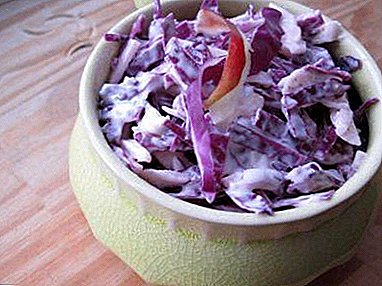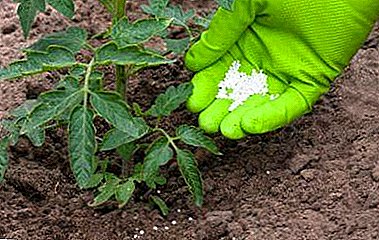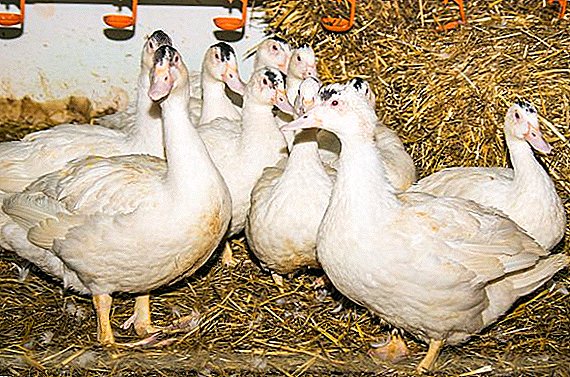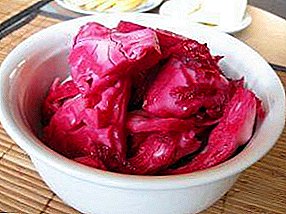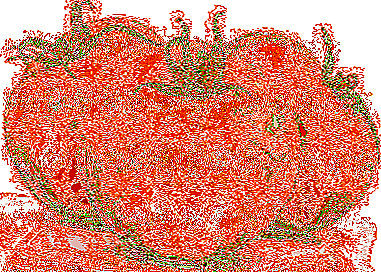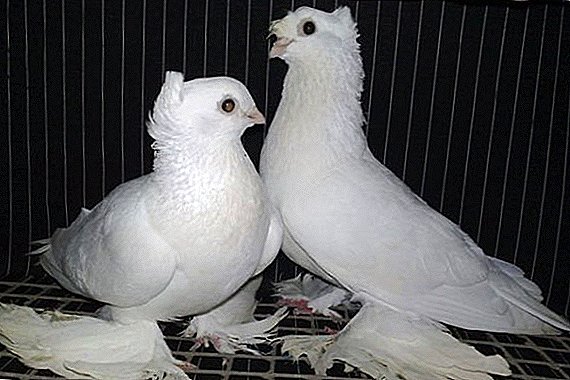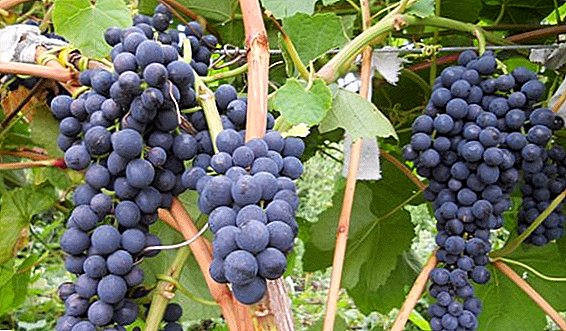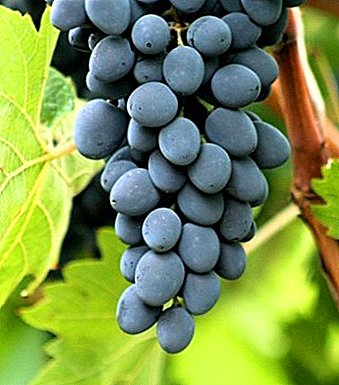
The berries of Moldova grapes are tasty, dense enough, even with a good degree of ripeness. Due to this, the taste qualities of this variety are known far beyond the region of culture breeding.
The appearance of healthy mature brushes is very is decorativetherefore, they can be used to dessert to the holiday table.
What kind is it?
"Moldova" - black table, ripening late, clusters of which reach consumer maturity from the second half of September.
Black grape varieties also include Black Finger, Bull's Eye, Black Pearl.
When grown on an industrial scale, the crop is sent for sale fresh, stored for later sale, processed into juice and wine. In private farms, this grape is used to make drinks, make jams, preserve, and freeze.
Description of the Moldova grape variety
Vines powerful, light brown. The color of foliage is green. The leaves are round, large, five-lobed, with a weakly meshed plate and a light edge along the underside. Flowers bisexual.
The clusters have the appearance of an inverted cone, sometimes wings can form. Good berry content, average brush weight 300-600 years. When professionally performed thinning brushes on adult vines, the remaining clusters can eventually reach weight in 1 kg.
Underload grapes too bad!
Berries:
- with dense, but not stiff, oily-looking peel;
- slightly oval;
- medium size (25 x 19 mm);
- dark blue with a purple tint;
- the presence of a natural, easily washable whitish plaque is possible - pruina;
- weighing up to 6 g;
- number of seeds 2-3 pcs .;
- acidity of 8-10 g / l;
- sugar content 16-19% (the sweetness of the berries in the hands during storage increases with time).
Pulp:
- dense;
- juicy;
- purple with a greenish tint near the peel;
- with a slight plum flavor;
- moderately sweet.
A photo
With the appearance of the grape variety "Moldova" can be found in the photo below:






Breeding history and breeding region
 Interspecific hybrid of the Euro-Asian region.
Interspecific hybrid of the Euro-Asian region.
Homeland - Moldova.
Parental Vines:
- Guzal Kara;
- Save Villar 12-375.
In Russia, Ukraine, the variety was introduced in the mid-80s of the last century. The best yields are obtained in the farms of the southern region of Russia (Rostov Region, Krasnodar Territory), western, eastern and southern regions of Ukraine.
The variety Moldova was used when crossing to obtain the following grape varieties: Nadezhda Azos, Kuban, Kodryanka, Zarevo and some others.
Specifications
Yield: before 130 kg / ha. The maximum yield on fertile soil healthy vine gives from 8-10 years of planting (up to 150-160 kg).
Vigorous. The best yields are obtained with horizontal arbor cultivation. When the bush is thickened, the hands become less crowded, the berries become smaller.
Transportability bunches very high subject to the removal of several unripe brushes. Excellent quality (up to 3 months). Good transportability demonstrate Kishmish Radiant, Laura and Bogatyanovsky.
Average winter hardiness: unopened vines without any consequences endure winters with temperatures as low as -26, -28 degrees.
Resistant to phylloxera, gray rot, mildew.
Requires preventive measures against lime chlorosis, oidium.
Diseases and pests
 Oidium (powdery mildew), caused by a fungal culture.
Oidium (powdery mildew), caused by a fungal culture.
Signs:
- an outbreak of the disease occurs in June;
- affected foliage curls, partially / completely covered with greyish-white “dust”;
- when oidium appears on the inflorescences, they begin to dry and die;
- the berries of the infected brushes seem to be sprinkled with flour,
- the rind of the fruit loses its elasticity and, under the influence of the increasing volume of pulp, it bursts, exposing the seeds.
Effective methods of dealing with oidium:
- sprinkling foliage with sulfur powder on a warm, windless spring day (the air temperature should not be below 18 ° C);
- spraying with sulfur-containing solution, preparations: Byleton, Rubigan, Caratan.
Fomopsis - A disease affecting the foliage and stems of the vines caused by an optional saprophyte.
Signs:
- at the end of spring or early summer, green, or strongly lightened green spots with a dark blotch in the center appear on the green vines;
- thickened around tissue stains;
- affected leaves gradually curl, turn yellow and die off;
- dark brown dots appear on the shoots, strokes increasing in size with time, which leads to necrosis of shoots internodes, and then the entire whip (in advanced cases, the vine also dies);
- unripe berries acquire an uncharacteristic yellow-brown color, which eventually changes to purple.
Effective methods of dealing with fomopsisom:
- when a lesion is detected, all the fallen leaves from this vine should be burned;
- the following year, waiting for the appearance of three full leaves, the vine is sprayed with solutions with drugs: Ridomil Gold, Tiovit, VDG;
- when a disease is detected on the ovaries, the treatment is performed using solutions Quadrice, Scoredrug Sc.
Osami Moldova grapes are rarely precipitated as the berries ripen late.
Untidy clusters on frosty days become a treat for birds. With the onset of cold spells, the left hands attract starlings and other birds.
Sheet wrench - One of the frequent summer pests of the Black Prince. To fight it you need to start in the fall: collect the fallen leaves and burn (the ashes are then used as top dressing), inspect the stem of the vine in order to detect the pupae of the pest and their removal for destruction.
Rainfall during flowering leads to a significant decrease in yield.
Phylloxera - insects of lemon-yellow color, capable of killing the entire plantation in 5 years, sucking life-giving juices from the vines. Developing on the aboveground and underground parts of the plant, the parasite is characterized by a rapid rate of expansion of the colony. When infected, the bush after three years loses the ability to bear fruit and soon dries out.
For other diseases of the vine, read the individual materials of the site.
Features
 Separate variety “Moldova black” does not exist. Most likely, the confusion with the identification of the "new variety" was due to the difference in the color of the berries in the stage of technical and consumer maturity.
Separate variety “Moldova black” does not exist. Most likely, the confusion with the identification of the "new variety" was due to the difference in the color of the berries in the stage of technical and consumer maturity.
In order to transport the berries, the clusters are torn off somewhat unripe, when the color of the berries is not intense enough. Because of this, they seem just blue, not blue-black.
If you live in a region with enough rainfall in the summer (or there is the possibility of good watering), and the winters are not particularly severe, then you can grow Moldova grapes right on your site.
Choosing a sunny place for the bush is more spacious, but protected from drafts, in a couple of years you will be able to taste not only berries, but also delicious jam, juice or fragrant wine.
//youtu.be/Ry-GlYeYDKs


